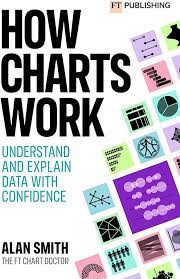The one-sentence summary
You can understand and explain data with confidence by mastering the principles of how best to represent information and by avoiding common data visualisation mistakes.
Can’t be bothered to read it? Too much screen time lately? Listen to the 5-minute podcast.
WHAT THE BOOK SAYS. 
- It is easy to be confused by charts since few people are actually trained in how to create or read them. Charts, graphs and tables are essential in business, but all too often they present information poorly.
- The book is written by the Head of Visual and Data Journalism at the Financial Times. It explains how to know your charts and how to put them to work.
- Technical areas covered include charts of:
Magnitude: relative or absolute size comparisons.
Change over time: giving emphasis to changing trends.
Correlation: showing the relationship between two or more variables.
Distribution: showing values in a dataset and how often they occur.
Flow: volumes or intensity of movement between two or more states or conditions.
Ranking: where an item’s position in an ordered list is more important than its absolute or relative value.
Deviation: emphasising variations above or below a fixed reference point.
Part to whole: how a single entity can be broken down into its component elements.
- The author has designed a visual vocabulary that guides you towards the right format of charts for each of these areas.
WHAT’S GOOD ABOUT IT
- The book is lavishly illustrated with colour examples so you can immediately see the pitfalls and benefits explained by the author.
- Our ability to interpret information visually, known as graphicacy, has long fallen between the gaps of academic curricula, but is needed more than ever.
- “Lurking behind chartjunk is contempt both for the information and for the audience. Chartjunk promoters imagine that numbers and details are boring, dull and tedious, requiring ornament to enliven…Chartjunk can turn bores into disasters, but it can never rescue a thin dataset…credibility vanishes.” Edward Tufte, pioneer of modern information design
- Missing data is often an issue: it always pays to question what simple charts don’t
- Missing variables are too: greater chart literacy comes from considering the variables that aren’t being shown.
- A grouped symbol chart is a form of pictogram, a type of graphic that uses repeating icons to show quantity. These were integral to the Isotype (International System Of Typographic Picture Education) method of statistical communication conceived in the 1920s.
- There is some fun to be had too. The spaghetti problem refers to line charts that are messy and hard to read because they have overlapping displays of too many lines. A hedgehog chart depicts rows of spikes in which forecast and actual figures have fluctuated wildly over time.
- Correlation and causation should not be confused. Sales of ice cream and violent crimes are correlated, but only because of warmer weather. Ludicrous examples abound, including per capita cheese consumption being strongly correlated with the number of people who died by becoming tangled in their bedsheets.
- Florence Nightingale was an early pioneer of well-presented data when she presented the causes of death in the British Army during the Crimean War. Apparently, she developed the approach in order to get the message through to Queen Victoria: “She may look at it because it has pictures,” she was quoted as saying.
WHAT YOU HAVE TO WATCH
- This will be an invaluable handbook for anyone who has to portray data and information. For the rest of us, it is of general interest but can become quite technical quite quickly.
